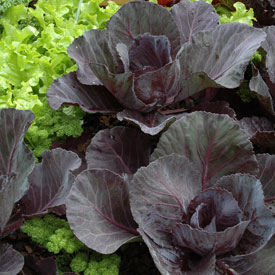Grow cabbage
Eating lots of cabbage - and other brassicas, such as broccoli, Brussels sprouts, cauliflower, cavolo nero, kale and Chinese greens – helps keep us ‘regular’ and reduces our risk of cancer. These staple winter greens are an excellent source of vitamins, minerals and dietary fibre, even more so when they’re eaten fresh from the home garden.
Even if it never makes it to the dinner table, the humble cabbage is worth growing for looks alone. Those shapely globes, in purple or green, look superb in the garden, and they’re quick and easy to grow.
Most brassicas are cool season crops, best started in autumn or earliest spring. The chill of winter brings out the sweetness of autumn sown cabbages but get them in early to make the most of the growing season before the winter cold slows their growth. Seed can be sown in trays or directly into the soil. Alternatively, seedlings are available in garden centres.
Planting brassicas
As with most vegetables, the better your soil, the better your cabbages. Choose a sunny spot with well-drained soil, or plant them raised planting beds. Add compost and a sprinkling of lime before planting,
Lime can make all the difference, especially in new gardens or acidic soils. Ideally, add lime at least a few days prior to adding any fertiliser. A general purpose fertiliser added at the rate of 150 grams per square metre will provide ample nutrients for the first few weeks. Later as plants grow, additional feeding once a fortnight will promote strong growth, better able to withstand attack by aphids and caterpillars.
Prevent soil borne diseases with crop rotation, i.e. avoid planting brassicas in the same soil as last year. A three-year rotation is even better. Carrots and parsnips are excellent follow-ups to brassicas.
Brassicas from seed
To discourage summer bolting, cabbages are usually sown in late summer or autumn, ideally into soil no colder than 20 Celsius. A clear plastic cover will help keep the warmth in, and can be gradually lifted to allow the seedlings to acclimatize to cooler air.
Light is important for the germination of some varieties so follow instructions and beware of covering seed with a thick layer of soil.
Cabbages can also be sown directly into well-prepared garden soil. Sow in clumps and later thin to the strongest seedling.
Cabbage Cuisine
- When a cabbage is cut, the vitamin levels quickly diminish, so eat them fresh from the garden.
- The darker the green the more Vitamin C, iron, and folate a leaf contains. The pale center leaves are much less nutritious.
- Overcooking depletes the nutritional content. A minute or two is all it takes to steam a sweet crunchy side dish, which won’t leave that lingering boiled cabbage odour.
- Chinese cabbages such as Wong Bok and Pak Choi are extremely quick growing and perfect for stir-fries or baby leaf salads.
- Kale is tastiest eaten while young. Ideally it should be sown in late summer or autumn.
- Giant Red mustard (Brassica rapa) is hot like wasabi and best in small doses, but the young leaves add a delicious tang to salads and this is a very pretty vege to grow for looks alone.
Red brassicas
Red cabbages contain the pigment anthocyanin which researchers say may help to prevent Alzheimer's disease. Anthocyanins are also found in broccoli, Brussels sprouts, cauliflowers, kales, mustards, and radishes. They’re also prevalent in strawberries, raspberries, blueberries, kidney beans, kumara skins, red apples and red wine.
Tip:
- To keep white butterflies off your cabbages, try covering them with horticultural insect mesh, available from garden centres.
7-Mar-2014


Red Cabbage


